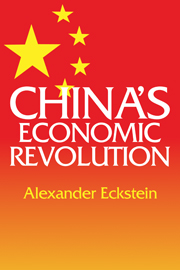Book contents
- Frontmatter
- Contents
- List of tables
- Preface
- 1 The economic heritage
- 2 Development strategies and policies in contemporary China
- 3 Property relations and patterns of economic organization in China
- 4 The resource-allocating system
- 5 The quest for economic stability
- 6 Economic development and structural change
- 7 The role of foreign trade in China's economic development
- 8 The Chinese development model
- Notes
- Index
5 - The quest for economic stability
Published online by Cambridge University Press: 28 October 2009
- Frontmatter
- Contents
- List of tables
- Preface
- 1 The economic heritage
- 2 Development strategies and policies in contemporary China
- 3 Property relations and patterns of economic organization in China
- 4 The resource-allocating system
- 5 The quest for economic stability
- 6 Economic development and structural change
- 7 The role of foreign trade in China's economic development
- 8 The Chinese development model
- Notes
- Index
Summary
The historical roots
As shown in preceding chapters, the Chinese Communist leaders dedicated themselves to transforming China into a modern socialist state. They had certain images of what the broad contours of that future state might be. These images were shaped by their ideology and world view on the one hand and by the realities of China's economic backwardness on the other. Both the ideas and the economic realities were to a large extent the legacy of the past. Therefore, one of the key problems facing the new leaders was how to build an economic system best adapted to attain their goals and objectives given the conditions inherited from the past. These were the issues addressed in Chapters 3 and 4.
Having constructed this economic system, what were its performance characteristics? How effective a vehicle did it turn out to be in pursuing and implementing the new regime's objectives? It is clear from the preceding chapters that to attain their goals, Chinese leaders pursued a high investment–growth strategy of development. Such a strategy was bound to generate inflationary pressures. Yet, as will be shown here, these pressures were contained very effectively. How this was done and what factors contributed to this outcome will be examined in this chapter.
With worldwide inflation and deep recession characterizing the mid-1970s, we are much more concerned about economic stability than we were some years ago. Policy makers and economists rather complacently assumed that they had at their disposal effective instruments for controlling inflation and unemployment in market economies.
- Type
- Chapter
- Information
- China's Economic Revolution , pp. 159 - 190Publisher: Cambridge University PressPrint publication year: 1977

